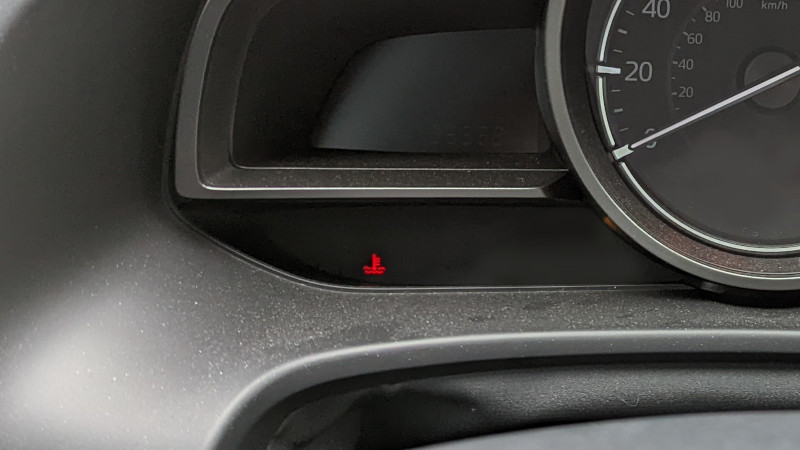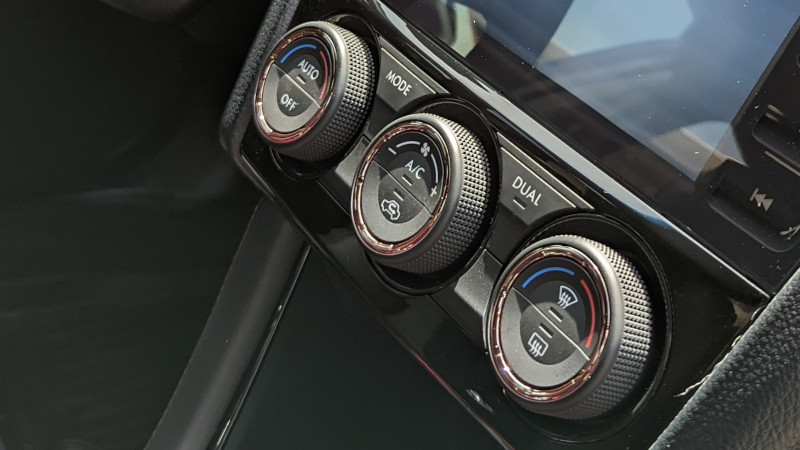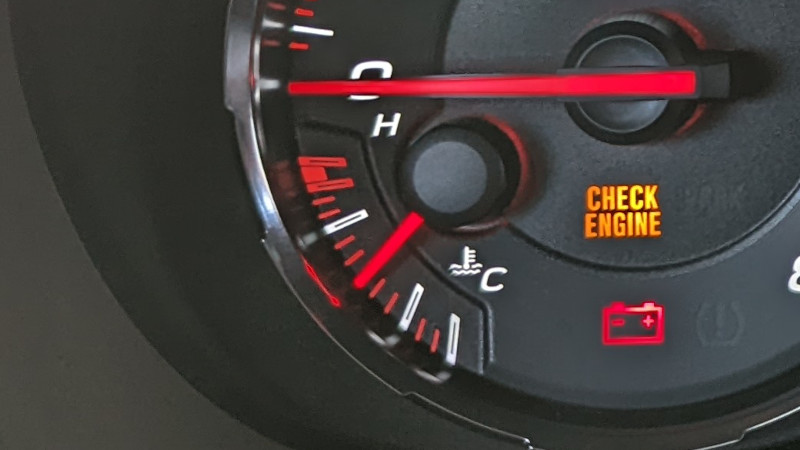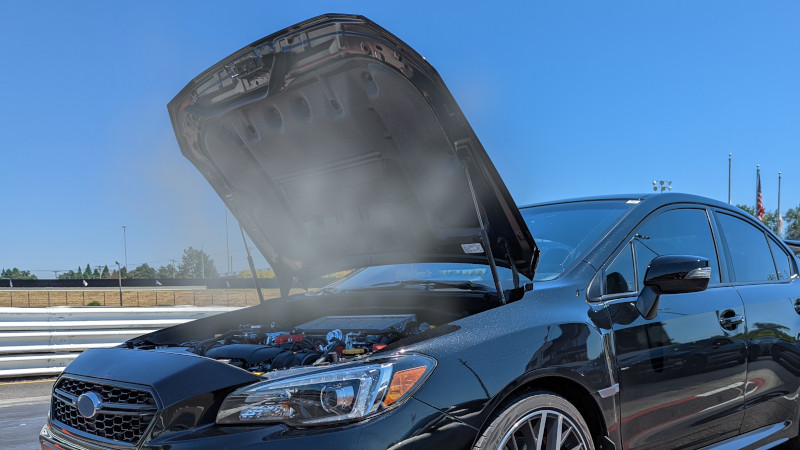Overheating your car is not a good thing. Not only can overheating cause more expensive engine damage, your car could quit working altogether and leave you stranded.
How Does the Cooling System Work?
Modern vehicles are equipped with water cooling. This means water or coolant (also called antifreeze) is circulated through the engine as the engine runs. The water pump, powered by the engine’s crankshaft, pumps coolant through the engine block.
Once the coolant heats up to a certain temperature, the thermostat opens, allowing the hot coolant to circulate through the radiator. Cold coolant from the radiator then moves back into the engine block. The thermostat closes once the engine temperature drops, and the cycle repeats.
The radiator requires airflow to cool the engine. If you’re not moving, the radiator fans will kick on to bring air through the radiator, dropping the temperature of the engine.
How to Stop Your Car From Overheating

If you notice the needle start to creep higher on your water temperature gauge (or notice a red temperature warning light), here are some steps you can take to keep your car from overheating.
1) Stop Driving
The best thing you can do when your car starts to run hot is to stop driving immediately. Find a safe place to pull off and shut down the car. Engines generate heat when they run. Give your engine some time to dissipate that heat.
You can either call a tow truck or try to diagnose the issue. Sometimes you can find a cooling system issue just by popping the hood and looking around. Perhaps you sprung a leak in a coolant hose and your coolant level dropped too low. Perhaps one of the radiator fans came unplugged.
If you see steam coming out from under the hood, wait until the car cools down before you pop the hood and take a look. You may have a leak that could spray hot coolant on your hands or face.
The cooling system is pressurized when hot, and the temperature will be well above boiling. Never open the cooling system while the engine is hot.
2) Turn on the Heat

The heater in your car uses what’s called a heater core to transfer hot air from the engine block into the cabin. The heater core is essentially a small radiator.
If you crank up the heat in the cabin, many engines will run a bit cooler. This is because some of the heat from the engine is transferred into the cabin instead of relying on the main radiator to dissipate that heat.
If your heater feels hot, then cold, then hot again, you may have air in your cooling system. This can happen when you have a leak in the cooling system, such as a bad radiator or coolant hose. A head gasket leak or an intake manifold gasket leak could also bring air into the system.
3) Top Off Your Coolant
If your coolant is low, you may be able to simply add antifreeze or water to get your car to stop overheating. Distilled or deionized water can be used in place of antifreeze.
If all you have is water, make sure you flush the cooling system once you get back home with something that has some corrosion resistance. You don’t want rust in your engine.
It’s a good idea to bleed the cooling system any time your coolant is low. Air pockets can create hot spots in the engine, and can cause issues such as warping and overheating.
4) Take It Easy
A car at wide open throttle will generate more heat than one that’s cruising on the highway. If your car is prone to overheating, try not to push the car very hard until the issue is resolved.
5) Check Your Oil
Oil? Really? Yes, lubrication issues can make your car run too hot. When your oil level is too low, it’s been a while since you changed the oil, or you’re running the wrong viscosity, you could see higher engine temperatures. Low oil means more friction inside the engine. Friction increases heat and engine wear.
Oil transfers some heat out of the engine, albeit less than coolant. Make sure you’re running the correct oil viscosity and capacity for your vehicle. Fun fact: old air cooled engines were technically also oil cooled.
6) Check Your Temperature Gauge

Many temperature gauges are not accurate. Once the needle starts to move off center, the car is often already running a bit too hot to be safe.
Don’t wait for the needle to be pegged all the way at the “hot” side. If the needle is starting to creep upwards, it’s time to pull over and figure out what’s going on.
7) Check Your Codes
What happens if you have a bad coolant temperature sensor or a broken temperature gauge? Well, that depends. Many vehicles will throw a check engine light when the coolant temperature sensor stops working.
If you notice the check engine light come on, don’t panic. It’s often safe to keep driving to your destination. You should get that check engine light scanned as soon as possible though. If you see any of the following codes, don’t trust your temperature gauge.
P0115 Engine Coolant Temperature Circuit Malfunction
P0115 means the engine control unit (ECU) has detected an unusual signal from the coolant temperature sensor, which means its reading cannot be trusted.
P0116 Engine Coolant Temperature Circuit Range/Performance Problem
P0116 essentially means the values the coolant temperature sensor is feeding the ECU don’t make any sense. For instance, the sensor shouldn’t give the same value when the engine is cold and when the engine is hot, because those are very different temperatures.
P0117 Engine Coolant Temperature Circuit Low Input
P0117 indicates the ECU has detected an unusually long duration for a low voltage from the coolant temperature sensor. For instance, the voltage may measure below 0.1 volts for 2.5 seconds or longer.
P0118 Engine Coolant Temperature Circuit High Input
P0118 indicates the ECU has detected an unusually long duration for a high voltage. For instance, the coolant temperature sensor may read above 4.9 volts for 2.5 seconds or longer.
P0119 Engine Coolant Temperature Circuit Intermittent
P0119 indicates that the coolant temperature sensor is giving a sporadic reading that is not possible in the real world. The coolant cannot heat from 32 degrees Fahrenheit to 190 degrees Fahrenheit within a fraction of a second. It takes several minutes of normal operation to heat the engine.
P0128 Coolant Thermostat (Coolant Temp Below Thermostat Regulating Temperature)
P0128 may indicate that your thermostat is stuck open. When the thermostat is open, the vehicle may not be able to warm up fully. Engines are much less efficient below operating temperature.
Conclusion
While overheating can have serious consequences for your engine, it is not a major safety concern like failing brakes or airbags. If you notice your car is overheating, don’t panic. Keep driving until it’s safe to pull over, and find a nice spot where you can stop for a little while.
If you have to stop in an area with a lot of traffic, throw your hazards on and consider using a road flare or some warning triangles. Sometimes you can drive a little further once the car cools down. If you’re not sure what’s going on, take the vehicle to a mechanic for a diagnostic of the cooling system.
